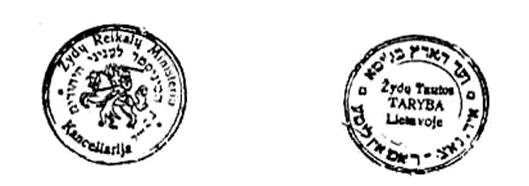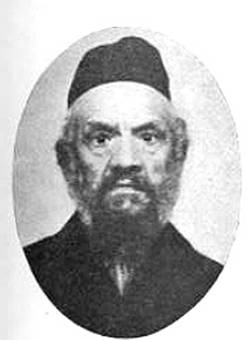Ligum
is situated in the north-central part of Lithuania, on the left bank of
the river Kruoja, about 27 km north-east of the district center Shavl (Siauliai).
An estate with the same name is mentioned in historic documents from the
15th century. Nearby the estate, the village grew mainly in the nineteenth
century, from 331 residents in 1841 to 801 in 1897, of them 482 (60%) were
Jews. Until 1795 Ligum was part of the Polish-Lithuanian Kingdom,
when the third division of Poland by the three superpowers of those
times ( Russia, Prussia and Austria) occurred. Lithuania then became
partly Russian and partly Prussian. The part of Lithuania which
included Ligum, fell under the rule of Czarist Russia (1795-1915).
From 1802 it was part of the Vilna province (Gubernia) and from 1843 it
became part of the Kovno province.
During
the period of independent Lithuania (1918-1940), Ligum was a county center
in the Siauliai district, with it's own county, police and post offices.
The town of Ligum also had several small factories for processing agricultural
products, some workshops and shops.
The
first Jews settled in Ligum during the 18th century. Until the beginning
of the 19th century there were more Jews in Ligum than in Shavl, and the
Ligum Jewish cemetery served Shavl Jews as well. Ligum Jews made
their living from small trade, crafts and peddling. After several decades,
they became the majority in town. At the beginning of the 19th century
Ligum had a "Beth-Midrash", a "Kheder" and other Jewish institutions.
In 1876 a
big fire occurred in Ligum which burnt down 60 Jewish houses. In
1887 another big fire burnt down 64 Jewish houses, including the
"Beth-Midrash" and the Synagogue.
In
the years before WW1 many of Ligum's Jews immigrated to America, England
and South Africa and at the start of WW1only 60 families remained. During
the summer of 1915 all Ligum's Jews were expelled to the inner regions
of Russia. After the war only 50 families returned to Ligum.
During
the period of independent Lithuania (1918-1940)
Following
the autonomy law for minorities, issued by the new Lithuanian government,
the Minister for Jewish Affairs, Dr. Menachem (Max) Soloveitshik, ordered
elections to be held for community committees (Va'ad Kehilah) in the summer
of 1919. In Ligum a committee of 5 elected members was formed. This committee
was active in almost all fields of Jewish life until the end of 1925.

On the Left: Stamp of the Jewish
National Council in Lithuania
On the Right: Stamp of the office
of the Minister for Jewish Affairs
According
to the Government's first census, taken in 1923, 753 people lived in Ligum,
of whom 240 were Jews (32%). During this period most of the Jews
made their living from agriculture, craft, peddling and small trade. The
weekly market day which took place on Wednesdays, accounted for their main
source of income. Almost every family maintained an auxiliary farm and
owned a milking cow. Several Jews worked at Yosef Perkis' wool spinning
and dyeing plant.
According
to a government survey done on shops and factories in Ligum in 1931, there
was only one Jewish butcher shop and one Jewish grocery shop.
During
"Khol Hamoed Pesakh" 5693 (13.4.1933) a big fire broke out in Ligum which
burnt down 87 buildings in the center of the town. Of these 87 buildings,
44 of them were habitations. Many people became roofless and calls for
helping the victims of the fire were published in the press. By WW2 most
of the houses were rebuilt.
In
1937 there were 6 Jewish craftsmen and tradesmen in town: 2 butchers, 1
tailor, 1 shoemaker, 1 tinsmith and one unspecified.
There
was an Hebrew school in Ligum, but it closed after two years, because it
did not have enough pupils to sustain itself. Some of the children then
attended a local Lithuanian school, and the more prosperous families
sent their children to Hebrew schools in Shavl and Kovno. Boys also attended
the "Kheder" of Meir the slaughterer, who taught school in addition to
his main profession.
Most
of Ligum's Jews were fans of the Zionist movement, but a small percentage
of the Jewish youth were active in the Communist underground.
In the table below we can see how
Ligum's Zionists voted for the different parties at seven Zionist Congresses:
|
Congress
Nr. |
Year |
Total
Shkalim |
Total
Voters |
Labor
Party |
Revisionists |
General Zionists
|
Grosmanists |
Mizrachi |
|
Z"S |
Z"Z |
A
|
B
|
|
14 |
1925 |
28 |
--- |
--- |
--- |
--- |
--- |
--- |
--- |
--- |
|
15 |
1927 |
14 |
--- |
--- |
--- |
--- |
--- |
--- |
--- |
--- |
|
16 |
1929 |
15 |
8 |
--- |
3 |
--- |
2 |
--- |
--- |
3 |
|
17 |
1931 |
30 |
23 |
--- |
4 |
1 |
--- |
--- |
--- |
18 |
|
18 |
1933 |
--- |
19 |
2 |
8 |
4 |
--- |
--- |
5 |
|
19 |
1935 |
--- |
24 |
7 |
--- |
--- |
4 |
--- |
13 |
|
21 |
1939 |
32 |
24 |
10 |
--- |
2 |
--- |
National Block
12
|
The
elections took place in 1931 in the "Zionist Hall" and in 1939 in the "Beth
Hamidrash".
The relations
between the Jews with their Lithuanian neighbors were by and large normal,
but sometimes incidents occurred like the desecration of the Jewish cemetery.
In
1933 a big fire caused a large amount of damage to the properties of about
30 Jewish families, of which only 10 were insured. At the same time the
economic situation of the Jews worsened because of strong competition
from Lithuanian organizations headed by the Lithuanian Merchants Association
"Verslas". Because of their harsh situation quite a few families
received support from their relatives abroad.
For a partial
list of Rabbis who served in Ligum see Appendix 1.
During
World War II
In
June 1940 Lithuania was annexed by the Soviet Union, becoming a Soviet
Republic. The new rule caused many changes in the economic and social life
of Ligum. Some of the Jews now found work in government economic institutions (like clerks etc. where Jews were
not previously accepted during the Lithuanian rule). The supply of goods decreased
and as a result prices soared. The middle class, mostly Jewish, bore most
of the brunt, and the standard of living dropped gradually. All Zionist
parties and youth organizations were disbanded and relations between
Jews and Lithuanians worsened. In 1940 there were about 120 Jews in Ligum.
On
the 22nd of June 1941, the German army invaded Lithuania. Many of Ligum's
Jews tried to escape to Russia on carts and by foot through Dvinsk
in Latvia, but arriving at the Latvian border on the 28th of June, they
found that the German army preceded them. Consequently they had to return
home. In Ligum the Lithuanian nationalists already became the rulers. With
the pretext of searching for arms, the Lithuanians stole personal things
and valuables from Jewish houses. They also detained Jews with the pretext
that they were Communists. Among the captives were prominent people, merchants etc. All were transferred to a Shavl prison where they
were murdered.
What
follows is the testimony of a young Lithuanian woman, Julija Butkute, born
in 1915, saved in the "Special Lithuanian Archives" LYA. F.K-1.B.198. P.
2-4., on the fate of Ligum's Jews:
"Ligum's
Jews were detained at the end of July and the beginning of September 1941.
The detained men were kept in a cellar of some building, and the women
were kept in the synagogue. During the night of the 3rd of September through
the night of the 4th, the men and young women were shot, in the Junkaiciai
forest,. The murder began early in the morning at about 6 o'clock.
In town we could smell the odor of the gunpowder. After the "Aktion" the
participants, among them the chief of Ligum's county police, Jonas Petraitis,
gathered in the town club, where refreshments were served. Four German
officers coming from Siauliai also took part in this gathering.
After
several days--another AKTION. 25 carts were provided for transferring the
mothers with their children to the murder site. All began early in the
morning. The women were relieved that the convoy was going to Zagare, where
they and their mature children would have to work. The women placed
their few belongings into the carts and then the carts started moving.
The women and children were taken only to the Junkaiciai forest. By the
middle of the day, at 12 o'clock, the aktion was already finished. In town,
the carts returned, loaded with Jewish belongings. The garments of the
(murdered) women and their packed personal belongings, from the carts,
were stored in a storehouse previously owned by a Jew.
For
the participants of the "Aktion", another party in the club was again organized,
with lots of alcohol. After taking part in the party for about half
an hour, the Germans returned to Siauliai".
For
a partial list of personalities born in Ligum see Appendix 2.
Sources:
Yahaduth Lita, (Hebrew) Tel-Aviv, Volumes
3-4
Yad Vashem Archives: Koniuchovsky Collection
0-71, Files 109
Yad Vashem Archives: File on Legum
M-9/15(6).
Central Zionist Archives: 55/1788;
55/1701; 13/15/131; Z-4/2548.
Kagan Berl,. Shtet, Shtetlach un Dorfishe
Yishuvim in Lite biz 1918 (Jewish Towns, Small Towns and Rural Settlements
in Lithuania till 1918) (Yiddish) pages 251-251, New-York 1992.
Kamzon Y.D.-Yahaduth Lita, page 168
Dos Vort, Kovno (Yiddish): 25.10.1934.
Folksblat, Kovno (Yiddish): 14.4.1933;
19.6.1933
Di Yiddishe Shtime (The Yiddish Voice)
Kovno (Yiddish): 23.7.1929; 14.4.1933; 19.4.1933.
Di Tseit (Time) (Yiddish) Kovno, 21.5.1939
Masines Zudynes Lietuvoje (Mass Murder
in Lithuania) vol. 2, page 404, Vilnius 1941-1944 (Lithuanian).
Dov Levin- Ligum (Lygumai), Pinkas
Hakehillot Lita (Encyclopedia of Jewish Settlements in Lithuania) (Hebrew),
Editor: Dov Levin, Assistant editor: Yosef Rosin, Yad Vashem. Jerusalem
1996.
The Book of Sorrow, (Hebrew, Yiddish,
English, Lithuanian), Vilnius 1997.
Appendix 1
A partial list of Rabbis who served
in Ligum:

Rabbi
Mordekhai-Yitskhak Rabinovitz
Nahum Shapiro (1818-1902)
Tzvi Yehudah Rabinovitz, In 1876 he was
in Ligum, died at the age of 44.
Dov Rabinovitz, until 1887
Mordekhai-Yitskhak -Aizik Rabinovitz,
(1856-1920),
Rabbi in Ligum from 1887-1902, published several books.
Moshe Horowitz, Rabbi in Ligum
from (1907-1915), immigrated to America, published several books.
Yisrael-Nisan Taitz, lived
in Ligum till about 1921.
Yehudah-Leib Laba, the last
Rabbi of Ligum, was murdered in 1941.
Appendix 2
A partial list of prominent people
born in Ligum:
Mordechai Bezalel Schneider
(1865-1941). After 1896 he lived in Vilna where he was a central personality
in education and Zionism, and wrote research articles in the Hebrew
language for Hebrew periodicals. (Hashiloakh, Hatekufah etc.). Published
two volumes of his comprehensive book "The theory of the Hebrew language
in its historic development" (Vilna, 1939-1940). The third volume was ready
to be printed, but the incoming Soviet rulers destroyed the printingmatrixes.
He was murdered in Ponar in 1941.
Rafael Rabinovitz (1897-
?), was the director of the Hebrew high school in Rasein (Raseiniai) and
later the director of the Hebrew teachers seminar "Tarbuth" in Kovno. After
1932 he lived in Tel-Aviv, where he practiced as a lawyer. He was in charge
of publishing, the "HaTalmud HaMenukad" ( The voweled Talmud).
Gershon Weitsman, established
the first match factory "Nur" in Eretz Yisrael in Ako. |

